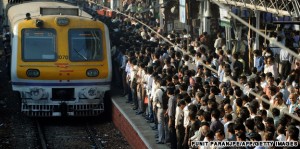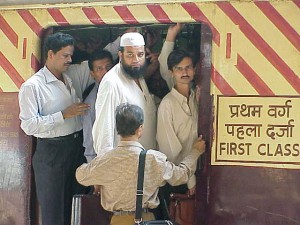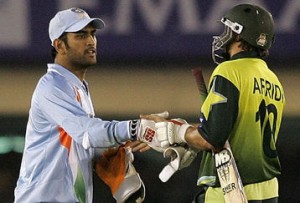At the very onset, before we move even move an inch, here are some current statistics on India for some ready consumption:
- Real GDP growth – 7.1% (vs. 6.9% year earlier) *link
- Inflation – 3.17% in Jan’17 (the lowest ever) *link
- Foreign Exchange Reserves – $360 bn (vs. $294 bn in Mar 14) *link
- Net FDI flows – $46 bn (up by 18%) *link
- Current account deficit – $22.1 bn (down from -$26.8 bn last year) *link
- Fiscal deficit (% of GDP) – 3.2% (vs. 3.99% last year) *link
- Competitive Index – 4.52 points out of 7 (the 2016-2017 Global Competitiveness Report) *link
- Per capita income – Rs. 103818 (vs. 94178 last year) *link
- Financial inclusion – 260 million PMJDY accounts in Dec’16 *link
- LPG for Poor – 5 lakh new connections given to poor *link
And to top it all, in November 2016, the Indian government undertook a step that not only surprised its own citizen, but flabbergasted the world. It demonetized the high-currency notes (1000 & 500) that accounted for over 80% of total market cuurency circulation. Everything went into a tizzy, there were serpentine queues, there were issues of liquidity, yet, the government kept working on it, and within a span of 90-days, things were all normal. Not to forget, they were normal and Digital.
Sone ki chidiya?
In fact, after a flurry of global economist debunking demonetization or predicting doom, things have much changed. There is a growing consensus that if the requisite 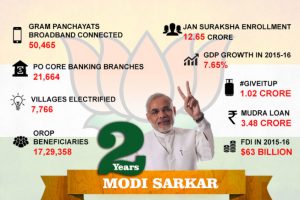 complementary actions towards digitization are undertaken, demonetization could actually accelerate the shift to a cashless — thereby transparent and yes, less corrupt — society. Recently, the Secretary General of Paris-based Organisation for Economic Cooperation and Development (OECD), Angel Gurria came all out in support of demonetization. “India has been a star performer in gloomy times. We do not have many cases of 7% growth (GDP). It is a top reformer among all the G-20 countries” he stated at an event.
complementary actions towards digitization are undertaken, demonetization could actually accelerate the shift to a cashless — thereby transparent and yes, less corrupt — society. Recently, the Secretary General of Paris-based Organisation for Economic Cooperation and Development (OECD), Angel Gurria came all out in support of demonetization. “India has been a star performer in gloomy times. We do not have many cases of 7% growth (GDP). It is a top reformer among all the G-20 countries” he stated at an event.
Even on the foreign policy, India seems to be doing fairly well. China’s all caught up in the South China Sea, in North Korea, or back home, to really bother about us. Pakistan, well, it is there and will be. Russia is busy in the US, Europe is stagnating, so is South Asia, and President Trump is doing wonderful things in the US. Our influence and our equity has improved under the current government’s watch.
Now given all these facts and stats, one would naturally assume that Indians would be smug about themselves, happy, proud, ecstatic if not outright boisterous celebrations with Old Monk and Thumbsup.
Right? Right? RIGHT?
Rather strangely, No! Now imagine, if you were a tourist who’s come down to India, and wants to get a feel of things from news channels, print papers and digital medium about the mood of the nation. Well, in case you did, it would depress the daylights out of you. All that is there to read and watch are things about all these poor students that are being viciously attacked, daughters of martyrs are being threatened with rape, celebs that troll, ministers that patronize, I mean, generally, all things would seem so murky, sad and disconcerting. Suddenly, the India that the stats above extol, and the India that is represented is in absolute contrast to each other. So, while we celebrate the multiplicity of god, have we Indians also discovered the multiplicity of truth?
Chimp sniffer
Of all the strange things that monkeys do, there’s this one trait that still takes the cake, sniffing — you know — sniffing their own bottoms. A lot many monkeys (apes, etc) have been observed with such a deplorable trait, putting their finger in the bum and then sniffing at it. Usually it ends in a disaster or disgust, like it did here. But no one has been able to fathom, why they actually do it. I mean, all is good, hunky-dory, and they’d put the finger there, sniff it and suffer.
Now, I believe, there’s this one trait that a few-many humans are inclined with. After all, we aren’t all that genetically different from our butt-sniffing cousins. There’s this chance that a quite a few of those habituated ones are currently residing in India and by sheer serendipity of life, are now at top positions in the media business, fashioning the outlook and the slant of the society with their morbidity. From their perch on the top, these ravens of despondency, relentlessly croak their views spreading all melancholy around.
And if that wasn’t enough, quite a few of these human-chimp sniffers can also be found on the social media sites, writing poignant messages or tweeting scathing masterpieces. Continue reading …
 Bhat’s death seems to be like deja vu, a replay, of the anarchy that had gripped the Valley last year when Burhan Wani, another Hizbul terrorist, was gunned down by Indian forces.
Bhat’s death seems to be like deja vu, a replay, of the anarchy that had gripped the Valley last year when Burhan Wani, another Hizbul terrorist, was gunned down by Indian forces.  Meanwhile, back in mainland India, Kashmir is portrayed as a law and order problem, Pakistan is blamed for fanning the flames of violence, and so on. The common argument is that till 1989, weren’t the Kashmiris cohabiting with Indians happily, letting the Yash Chopras of the world shoot Bollywood movies in the charming locales. Now, if azaadi was not desirable till the 90s, how did the game change so drastically and dramatically? Why did the Shikara-driving or Kahwa-sipping Kashmiri suddenly develop political ambitions and such massive ones?
Meanwhile, back in mainland India, Kashmir is portrayed as a law and order problem, Pakistan is blamed for fanning the flames of violence, and so on. The common argument is that till 1989, weren’t the Kashmiris cohabiting with Indians happily, letting the Yash Chopras of the world shoot Bollywood movies in the charming locales. Now, if azaadi was not desirable till the 90s, how did the game change so drastically and dramatically? Why did the Shikara-driving or Kahwa-sipping Kashmiri suddenly develop political ambitions and such massive ones?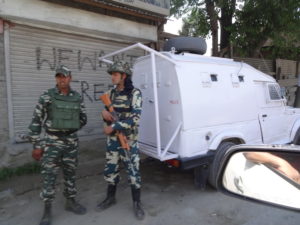 the camps, the schools, the ATMs, everywhere that you see are men in fatigues armed with automatics. One gets a rather odd feeling at seeing such pervasive military presence. I mean, you kind of wonder, whether you have accidentally landed in Kabul or Baghdad instead of Srinagar.
the camps, the schools, the ATMs, everywhere that you see are men in fatigues armed with automatics. One gets a rather odd feeling at seeing such pervasive military presence. I mean, you kind of wonder, whether you have accidentally landed in Kabul or Baghdad instead of Srinagar.
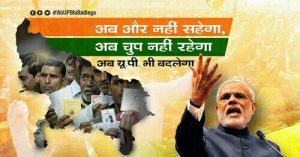 Shekhar, Atal Behari Vajpayee and now even Narendra Modi. In a sense of terms, UP is like the steering-wheel of Indian politics, he (or she) who controls UP, can steer the politics of this nation in his/her wake.
Shekhar, Atal Behari Vajpayee and now even Narendra Modi. In a sense of terms, UP is like the steering-wheel of Indian politics, he (or she) who controls UP, can steer the politics of this nation in his/her wake.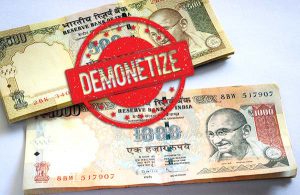 each person’s account to give a size of the problem. Yet, while the figure was notional, it was used a baton to whack BJP and especially PM Modi every now and then. “Where’s the black money in my account?” had become a common jibe by the opposition party leaders like Rahul Gandhi, Arvind Kejriwal, Mamta Banerjee and so on.
each person’s account to give a size of the problem. Yet, while the figure was notional, it was used a baton to whack BJP and especially PM Modi every now and then. “Where’s the black money in my account?” had become a common jibe by the opposition party leaders like Rahul Gandhi, Arvind Kejriwal, Mamta Banerjee and so on. complementary actions towards digitization are undertaken, demonetization could actually accelerate the shift to a cashless — thereby transparent and yes, less corrupt — society. Recently, the Secretary General of Paris-based Organisation for Economic Cooperation and Development (OECD), Angel Gurria came all out in support of demonetization. “India has been a star performer in gloomy times. We do not have many cases of 7% growth (GDP). It is a top reformer among all the G-20 countries”
complementary actions towards digitization are undertaken, demonetization could actually accelerate the shift to a cashless — thereby transparent and yes, less corrupt — society. Recently, the Secretary General of Paris-based Organisation for Economic Cooperation and Development (OECD), Angel Gurria came all out in support of demonetization. “India has been a star performer in gloomy times. We do not have many cases of 7% growth (GDP). It is a top reformer among all the G-20 countries”
 quite a simple book talking about the state of affairs of the world, especially in connection with globalization. The book speaks of how the world is coming together as one big place from Denver to Dalian to Bangalore. It was meant to be a chronicle of our times, and a sort of prognosis of the things that are yet to come. Friedman reaped rich rewards from his book, traveling across the globe, giving talks and discussing the subject.
quite a simple book talking about the state of affairs of the world, especially in connection with globalization. The book speaks of how the world is coming together as one big place from Denver to Dalian to Bangalore. It was meant to be a chronicle of our times, and a sort of prognosis of the things that are yet to come. Friedman reaped rich rewards from his book, traveling across the globe, giving talks and discussing the subject. and Mexico for the “greatest jobs theft” in the history of the world. According to him, Indians and other nationals were gobbling up American jobs. Indians were no more a threat, but rather scheming thieves that stole and cheated. Now how could that narrative change so quickly? What happened to that ‘flat world’ that was meant to be equal for all
and Mexico for the “greatest jobs theft” in the history of the world. According to him, Indians and other nationals were gobbling up American jobs. Indians were no more a threat, but rather scheming thieves that stole and cheated. Now how could that narrative change so quickly? What happened to that ‘flat world’ that was meant to be equal for all 
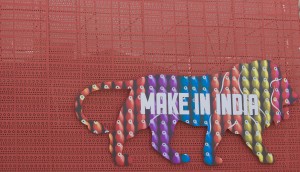 finding an auto becomes an ordeal, something as extraordinary as a Make In India Week (MIIW) seems completely unnecessary. Thus on spotting a green colour media pass for MIIW dangling from my neck, the gentleman in the hard-won share-auto could not help comment. “Auto strike to rokh naheen paya, phir itna bada nautanki kyun?” (The administration could not stall the auto strike, so what is the real need for such an event).
finding an auto becomes an ordeal, something as extraordinary as a Make In India Week (MIIW) seems completely unnecessary. Thus on spotting a green colour media pass for MIIW dangling from my neck, the gentleman in the hard-won share-auto could not help comment. “Auto strike to rokh naheen paya, phir itna bada nautanki kyun?” (The administration could not stall the auto strike, so what is the real need for such an event).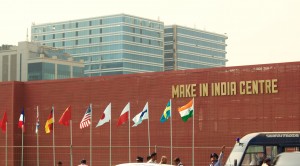 down. Somehow, that anecdote seemed apt to me. It seems that we Indians seem to have a problem with success, especially when it is of our very own. We find it hard to digest, to come to terms with it. So we lash out at it, debunk it, call it useless, futile, nautanki, etc.. That is a typical way in which many react in India. But this trend has exacerbated with the coming the PM Narendra Modi. Everything now is perceived from a political prism, thus, if you don’t agree with him, everything he does has to be negative. So what if it is Skill India or Make In India?
down. Somehow, that anecdote seemed apt to me. It seems that we Indians seem to have a problem with success, especially when it is of our very own. We find it hard to digest, to come to terms with it. So we lash out at it, debunk it, call it useless, futile, nautanki, etc.. That is a typical way in which many react in India. But this trend has exacerbated with the coming the PM Narendra Modi. Everything now is perceived from a political prism, thus, if you don’t agree with him, everything he does has to be negative. So what if it is Skill India or Make In India?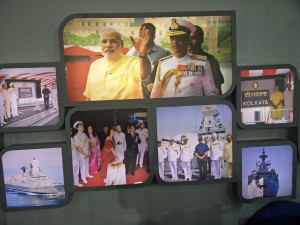 lithe manner. The term jamboree (essentially means a large congregation or party; extravagant and lavish. Usually, a boisterous affair.) is symbolic of that mindset, a perspective that has been tinged with ignorance
lithe manner. The term jamboree (essentially means a large congregation or party; extravagant and lavish. Usually, a boisterous affair.) is symbolic of that mindset, a perspective that has been tinged with ignorance